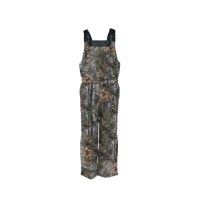
Overalls include elongated trousers, covering the legs, back, and chest. This clothing is great for hunting in the undergrowth woods. Winter overalls for hunting perfectly protect against cold weather but the movements will be somewhat limited, and you cannot quickly change the outer clothing. However, having a good bib overall still worth and here is what you should consider purchasing it.
Camo patterns
The coloring of the bib plays an important role for the hunter, as the ability to remain unnoticed and to hide in time determines the further success of the hunting. To choose the appropriate camouflage, you need to decide in what landscape conditions you will hunter. Winter hunting bib is released in light (white) colors; sometimes there are darker options.
Material

Cotton bib overall is the best choice for a hunter. It’s great for any weather conditions. Fleece-made bibs are also in great demand as it is quite and perfectly repels the moisture. There are also options like cotton/polyester bibs that also work great and allow wearing extra underneath clothes.
Polyester is a special kind of synthetic fabric made of polyester fibers. Fabric made of 100% polyester is:
- very durable and wear-resistant;
- light, well retains its shape;
- doesn’t wrinkle;
- resistant to heat and light;
- easily washed;
- does not need special care.
However, this material has insufficient air permeability.
Cotton is breathable and light material. The body perfectly perceives cotton. Here are a few more advantages of this material:
- it quickly absorbs any moisture;
- the structure of the canvas is quite porous, which allows to pass air;
- easy washable;
- can be easily colored that is good for making camo patterns.
However, cotton has a tendency to burn out and lose color saturation, and the overall made of cotton will be quickly worn out and crumpled.
Fleece is synthetic material and combines polyester and other artificial fibers what makes it to be light, moisture-repellent and unpretentious. Fleece has a number of advantages, here are the main ones:
- absorbs water vapor and brings it out;
- well retains its original shape;
- allows the skin to “breathe”;
- quickly dries;
- has heat-insulating properties, even when it’s wet;
- durable and wear-resistant.
However, there is one disadvantage – the fleece is fairly well electrified and easily ignited if it is not processed properly.
Water resistance
Melting snow or rain can bring a lot of trouble to the hunter and spoil all the fun. For a better quality of bib, manufacturers use a membrane or combined fabric, on which the outer strips are made, and the seams are strengthened with a special protective tape. This helps to avoid undesirable rustling, protects against moisture and keeps the heat. For example, pore membrane fabric has pores, but these pores are so small that they do not allow the moisture to penetrate into that enters the material from the outside. But with the moisture that accumulates inside the material, the situation is quite different. This moisture leaves without problems through the microscopic pores, thereby depriving you of the feeling of “wet pants” and other troubles. That is, this fabric does not allow moisture to escape from the outside, but it provides great breathable properties.
The combined membranes are more durable and wear-resistant, as there is a thin layer of free membrane film over the pore tissue. Thus, the fabric becomes absolutely waterproof, breathable, and durable. Overalls made of combined membranes have practically no disadvantages, except for one – the price.
To choose really high-quality waterproof overall bib, you should pay attention to the seams. Seams of membrane materials are glued so that moisture does not get inside the clothes, not only through the surface of the fabric, but also through the places where it is sewn. If you pick up a membrane overall and see the note “all seams are sealed”, it means that you have bib, which seams are glued, and it will not let moisture get in and keep your body dry. “Critical seam sealing” means that leaking of the seams is possible in some parts of the clothes.
Insulation
Modern hunting bibs perfectly retain heat and at the same time do not impede movements; they are not bulky or heavy. Buying a winter bib for hunting is better with a fleece lining since this fabric has the property of regulating the temperature inside of it. This allows you to feel comfortable in any weather conditions. For example, Gamehide Flatland Deer Hunting Bib has partially fleece-lining of some parts of the bib. TrailCrest Men’s Insulated & Waterproof Camo Bib also has excellent poly-fleece insulation.
Convenience
Hunting is an active activity, so it is possible that you can get caught somewhere or fall. Therefore, make sure that the fabric is strong and durable; the stitches should be stitched. The knees and other parts of the bib should be reinforced.
High-quality bib overall has articulated knee and seat system. It also should have lower leg zips so you easily can wear boots of any height.
Sound
Hunting requires staying quite as possible that is why it’s important the clothes should be made of less noisy materials. For example, Tricot is versatile fabric and known for its stealth. Give preference to soft fabrics. One of our best choice product has a Tricot shell – 10X Men’s Realtree Extra Waterproof Breathable Insulated Bib Overall.
Wildfowler Outfitter Camo Hunting Waterproof Insulated Bibs is also made of soft Tricot that stays as silent as possible.
Size
Since every manufacturer has own size chart, it can be difficult to define the size you need if you don’t have the size chart. Most of the bibs can be large than you expect it to be, but it always should fit your waist. The bib has to space at the belly button to feel comfortable in it. Remember that the big size of bib always has the longer length. Don’t forget that you may want to put on some underneath clothes for extra protection and warmth, so the bib should be a few inches bigger.
Why Bibs Are Comfortable?
First of all, because of their pattern, they are wind-resistant, and 80% of your body is kept warm. Most hunting bibs are waterproof and generally have useful details: many pockets, zipper legs, regulated length, and waist. Some of them have articulated knees, and sometimes you can partially unfasten the trouser legs. In this way, a bib seems to be a great option for transforming clothes for hunting; the best clothing for outdoor activities. You won’t feel the wind as you could when wearing trousers and a sweater or T-Shirt. You feel free in your movements, and there is a great assortment of colors too, including camo. In addition, most bibs are machine washable.
What Is Better: Hunting Coveralls or Bibs?

Hunting Coveralls: Advantages
- Warm and cover the whole body
- Has additional pockets
Hunting Coveralls: Disadvantages
- Fetters movement a bit
- Hard to regulate if you need something underneath or above
- Easy to get sweaty
Hunting Bibs: Advantages
- Versatile
- Easier to regulate the heat
- Complete freedom of movement
Hunting Bibs: Disadvantages
- Is not appropriate if you get cold too fast — but a bomber can solve the problem
To sum up, bibs seem preferable. They are warm enough, but if not — just add a bomber. While with coveralls, you can easily feel hot and there will be nothing you can do to change that. With bibs, you are more flexible in regulating the temperature, and while wearing it, you can change some of the parameters as well. The advantage of coveralls is that you can have some additional pockets. But is it worth the regular feeling of frozen sweat? We don’t think so. But if you get cold easily and you don’t have winter gear for a new season yet, it is better to wear coveralls. Still, you should think of something to wear with it.
What Is Better: Hunting Pants or Bibs?

Hunting Pants: Advantages
- Feeling comfortable as you’re used to wearing them every day
- Lighter than bibs
- Good in warm weather
Hunting Pants: Disadvantages
- The coat can wear out the trousers
- When you sit down, you can feel a draft between the pants and coat
- Fewer pockets
- Easy to drop something, or to lose things in the pockets
Hunting Bibs: Advantages
- Versatile
- Easier to regulate the heat
- Complete freedom of movement
- Keeping coat close to the body
- Additional insulation
Hunting Bibs: Disadvantages
- Buttons made from metal can be noisy
We can’t say that trousers are that bad, but bibs seem to be more practical. More of your body is covered, and there are additional pockets and insulation. It is more comfortable to wear a coat with a bib than with trousers because the coat is closer to the body. Pants are good in the summer, but in other seasons, we would definitely choose bibs. Plus, it’s easy to drop something out of the pocket of the pants and lose it. With pants, you may need an additional coat or bomber, while with a bib, one merino coat or even a turtleneck can be enough.
FAQ
To sum up all your questions about bibs, we’ve created a small FAQ for you.
Why do I need bibs?
Bibs are the most practical type of hunting gear. They are insulated, windproof, and you can regulate almost every detail while wearing them. You can take many things with you — thanks to the additional pockets. You don’t need additional coats or sweaters — the bomber is enough. Your movements will be comfortable and silent.
Are bibs only for the winter?
Bibs are good for every season, actually. Winter bibs just have additional insulation, while others will just be warm but not too much.
Why not coveralls?
Coveralls can make your moves feel less comfortable, and you can get sweaty too soon and then get cold again. Coveralls can be good for a very windy and snowy winter, but still, bibs are preferable.
Conclusion

Hunting in the extreme weather conditions requires a high-quality bib that covers your body. The bib keeps the body warm, resists water and wind. So, to make a good purchase pay attention how durable the bib is, what it is made of and how good it is insulated, whether it is easy to put on.

























